Web Programming Step by Step
Lecture 25
Cookies and Sessions
References: tizag.com sessions, cookies; Codewalkers
References: SQL syntax reference, w3schools tutorial
Except where otherwise noted, the contents of this presentation are Copyright 2009 Marty Stepp and Jessica Miller.
Stateful client/server interaction

Sites like amazon.com seem to "know who I am." How do they do this? How does a client uniquely identify itself to a server, and how does the server provide specific content to each client?
- HTTP is a stateless protocol; it simply allows a browser to request a single document from a web server
- in these slides, we'll learn about pieces of data called cookies used to work around this problem, which are used as the basis of higher-level sessions between clients and servers
What is a cookie?

- cookie: a small amount of information sent by a server to a browser, and then sent back by the browser on future page requests
- cookies have many uses:
- authentication
- user tracking
- maintaining user preferences, shopping carts, etc.
- a cookie's data consists of a single name/value pair, sent in the header of the client's HTTP GET or POST request
How cookies are sent
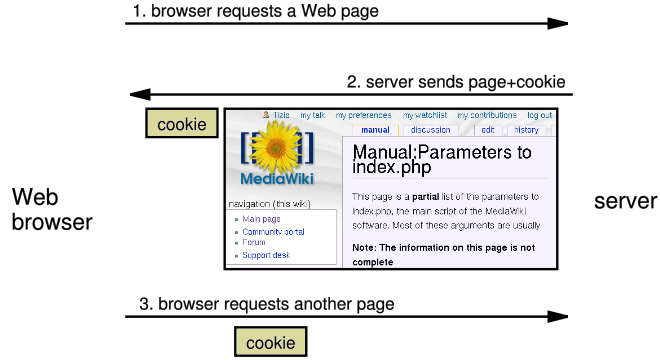
- when the browser requests a page, the server may send back a cookie(s) with it
- if your server has previously sent any cookies to the browser, the browser will send them back on subsequent requests
- alternate model: client-side JavaScript code can set/get cookies
Myths about cookies
- Myths:
- Cookies are like worms/viruses and can erase data from the user's hard disk.
- Cookies are a form of spyware and can steal your personal information.
- Cookies generate popups and spam.
- Cookies are only used for advertising.
- Facts:
- Cookies are only data, not program code.
- Cookies cannot erase or read information from the user's computer.
- Cookies are usually anonymous (do not contain personal information).
- Cookies CAN be used to track your viewing habits on a particular site.
How long does a cookie exist?
- session cookie : the default type; a temporary cookie that is stored only in the browser's memory
- when the browser is closed, temporary cookies will be erased
- can not be used for tracking long-term information
- safer, because no programs other than the browser can access them
- persistent cookie : one that is stored in a file on the browser's computer
- can track long-term information
- potentially less secure, because users (or programs they run) can open cookie files, see/change the cookie values, etc.
Where are the cookies on my computer?
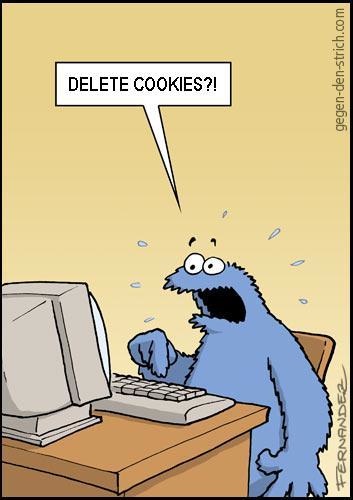
- IE: HomeDirectory\Cookies
- e.g. C:\Documents and Settings\jsmith\Cookies
- each is stored as a
.txtfile similar to the site's domain name
- Firefox: HomeDirectory\.mozilla\firefox\???.default\cookies.txt
- view cookies in Firefox preferences: Privacy, Show Cookies...
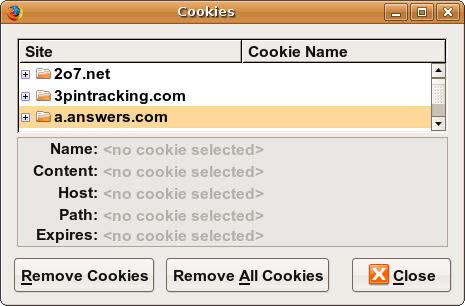
- view cookies in Firefox preferences: Privacy, Show Cookies...
Cookies in JavaScript
document.cookie = "username=smith;password=12345";
<!-- using the instructor-provided Cookies.js class -->
<script src="Cookies.js" type="text/javascript"></script>
Cookies.set("username", "smith");
...
alert(Cookies.get("username")); // smith
- JS has a global
document.cookiefield (a string) -
you can manually set/get cookie data from this field (sep. by
;), and it will be saved in the browser -
we have written a Cookies.js helper class with methods
set,get,exists,remove, andremember
Setting a cookie in PHP
setcookie("name", "value");
setcookie("username", "martay");
setcookie("favoritecolor", "blue");
setcookiecauses your script to send a cookie to the user's browsersetcookiemust be called before any output statements (HTML blocks,print, orecho)- you can set multiple cookies (20-50) per user, each up to 3-4K bytes
- technically, a cookie is just part of an HTTP header, and it could be set using PHP's
headerfunction (but this is less convenient, so you would not want to do this):
header("Set-Cookie: username=martay; path=/; secure");
Retrieving information from a cookie
$variable = $_COOKIE["name"]; # retrieve value of the cookie
if (isset($_COOKIE["username"])) {
$username = $_COOKIE["username"];
print("Welcome back, $username.\n");
} else {
print("Never heard of you.\n");
}
print("All cookies received:\n");
print_r($_COOKIE);
- any cookies sent by client are stored in
$_COOKIESassociative array - use
issetfunction to see whether a given cookie name exists
unsetfunction deletes a cookie
Setting a persistent cookie in PHP
setcookie("name", "value", timeout);
$expireTime = time() + 60*60*24*7; # 1 week from now
setcookie("CouponNumber", "389752", $expireTime);
setcookie("CouponValue", "100.00", $expireTime);
Removing a persistent cookie
setcookie("name", "", time() - 1);
setcookie("CouponNumber", "", time() - 1);
- if the server wants to remove a persistent cookie, it should set it again, passing a timeout that is prior to the present time
What is a session?
- session: an abstract concept to represent a series of HTTP requests and responses between a specific Web browser and server
- HTTP doesn't support the notion of a session, but PHP does
- sessions vs. cookies:
- a cookie is data stored on the client
- a session's data is stored on the server (only 1 session per client)
- sessions are often built on top of cookies:
- the only data the client stores is a cookie holding a unique session ID
- on each page request, the client sends its session ID cookie, and the server uses this to find and retrieve the client's session data
How sessions are established
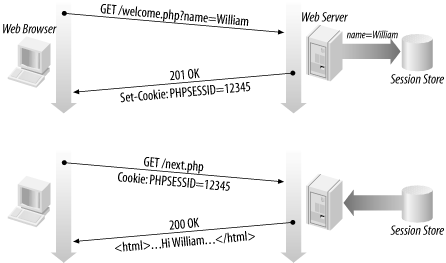
- client's browser makes an initial request to the server
- server notes client's IP address/browser, stores some local session data, and sends a session ID back to client
- client sends that same session ID back to server on future requests
- server uses session ID to retrieve the data for the client's session later, like a ticket given at a coat-check room
Sessions in PHP: session_start
session_start();
session_startsignifies your script wants a session with the user- must be called at the top of your script, before any HTML output is produced
- when you call
session_start:- if the server hasn't seen this user before, a new session is created
- otherwise, existing session data is loaded into
$_SESSIONassociative array - you can store data in
$_SESSIONand retrieve it on future pages
- complete list of PHP session functions
Accessing session data
$_SESSION["name"] = value; # store session data $variable = $_SESSION["name"]; # read session data if (isset($_SESSION["name"])) { # check for session data
if (isset($_SESSION["points"])) {
$points = $_SESSION["points"];
print("You've earned $points points.\n");
} else {
$_SESSION["points"] = 0; # default
}
- the
$_SESSIONassociative array reads/stores all session data - use
issetfunction to see whether a given value is in the session
Where is session data stored?
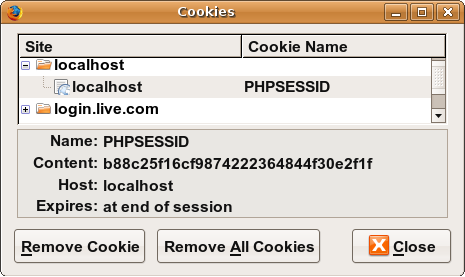
- on the client, the session ID is stored as a cookie with the name
PHPSESSID - on the server, session data are stored as temporary files such as
/tmp/sess_fcc17f071... - you can find out (or change) the folder where session data is saved using the
session_save_pathfunction - for very large applications, session data can be stored into a SQL database (or other destination) instead using the
session_set_save_handlerfunction
Browsers that don't support cookies
session_start(); # same as usual # Generate a URL to link to one of our site's pages # (you probably won't ever need to do this) $orderUrl = "/order.php?PHPSESSID=" . session_id();
- if a client's browser doesn't support cookies, it can still send a session ID as a query string parameter named
PHPSESSID- this is done automatically;
session_startdetects whether the browser supports cookies and chooses the right method
- this is done automatically;
- if necessary (such as to build a URL for a link on the page), the server can find out the client's session ID by calling the
session_idfunction
Session timeout
- because HTTP is stateless, it is hard for the server to know when a user has finished a session
- ideally, user explicitly logs out, but many users don't
- client deletes session cookies when browser closes
- server automatically cleans up old sessions after a period of time
- old session data consumes resources and may present a security risk
- adjustable in PHP server settings or with
session_cache_expirefunction - you can explicitly delete a session by calling
session_destroy
Practice problem: remembering query
- Modify the
movie.phpmovie search script from previous lectures so that it remembers the current user's last query (if any), and offers the user a chance to search for it again, such as:- Welcome back! Would you like to repeat your recent search for Fight Club?
- Pretend that the movie-search program is running on a system that wants to limit repeated usage by particular users. Add code so that a given user can only conduct one session per day.

